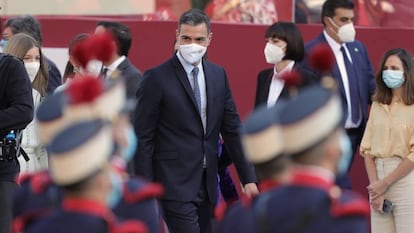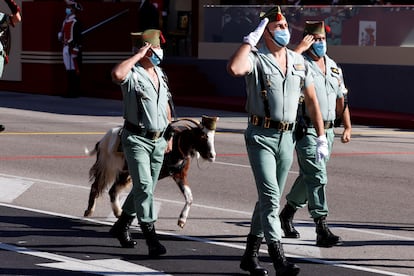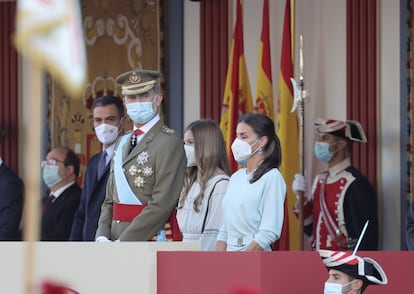Spain’s PM booed at military parade to observe National Day
Despite recommendations to stay home, thousands turned up in Madrid for a traditional event that was canceled last year due to the coronavirus health crisis
Spain observed its National Day on October 12 with a military parade that was smaller than usual but which symbolized a gradual return to normality following last year’s strict coronavirus restrictions. Thousands of people turned up for the event despite recommendations by health authorities to watch it on television to reduce the risk of virus transmission.
Prime Minister Pedro Sánchez of the Socialist Party (PSOE), who heads a leftist coalition, was booed by members of the public as he arrived at Castellana boulevard in Madrid on Tuesday morning. The jeers continued during the military parade, with the public yelling “get out” and “resign, Sánchez.”
The annual event, which began at 10.30am, was attended by King Felipe VI and Queen Letizia as well as leading government officials, including the largest delegation to date of the leftist Unidas Podemos, the junior partner in Spain’s governing coalition and traditionally a detractor of ceremonies featuring the military or the royals. Pablo Echenique, spokesman for Unidas Podemos in the lower house of parliament, tweeted that “patriotism is not something you say. Patriotism is something you do” and asked for more government action against unemployment, soaring rent and windfall profits for energy companies.

Former deputy prime minister and Podemos co-founder Pablo Iglesias used the incident involving Sánchez to criticize the Spanish monarchy. “The applause for the head of state and the boos for the government only express what’s obvious: the monarchy is a political symbol for the right and far right. And for no one else. An institution that only sparks attachment from this part of the country has a very compromised future,” he wrote in a message on Twitter.
In a Twitter message ahead of the parade, Sánchez had asked Spaniards to observe the date by “defending what unites us, what makes us great as a society, what makes Spain a welcoming, open, diverse country. Let us celebrate our commitment, solidarity, cooperation and multilateralism.”
Princess Leonor, first in line to the Spanish throne, was not among the dignitaries watching the parade as the 15-year-old is currently at a boarding school in Wales, and traveling to Spain for the event would have meant quarantining for five days upon her return, said sources at the royal residence. Leonor’s sister, the Infanta Sofía, was present.
Smaller event

The annual parade returned to the landmark thoroughfare following its replacement last year with a low-key ceremony at Madrid’s Royal Palace. Although Spain has now entered the low-risk Covid scenario, this year’s display was nevertheless held on a reduced scale: 2,656 troops marched down the boulevard, compared with 4,200 in 2019; there were 115 vehicles (down from 150) and 68 aircraft (there were 76 in 2019).
The route was also shortened to a little under two kilometers, and there were no tracked combat vehicles. There had been plans to instead show off a prototype for the new armored eight-wheel-drive Dragón, developed specifically for the Spanish Army, but it was taken off the program at the last minute, according to military sources.

The slogan of this year’s parade was “Service and commitment,” meant as a reminder of the armed forces’ work at times of crisis, most recently during the Covid pandemic and the volcanic eruption on the island of La Palma. “The armed forces will always be on the side of citizens [...] wherever there is need or danger,” said Defense Minister Margarita Robles in a video address to troops stationed abroad.
Although the annual military parade is carefully planned and aircraft always hold practices ahead of their air shows, accidents occasionally happen. In 2019 a parachutist holding a Spanish flag got caught on a streetlamp; two years before that, in a much more tragic incident, a Eurofighter crashed as it was returning to Los Llanos air base in Albacete, killing the pilot.
Anthem controversy
The official anthem used by Spain’s armed forces and law enforcement agencies to honor their dead, La muerte no es el final (or, Death is not the end) has come under fire after over a dozen people accused its creator, a priest named Cesáreo Gabaráin, of sexual abuse in the 1960s and 70s.
The song is routinely played at official events, including the October 12 military parade. Gabaráin’s accusers say it is an insult; the defense and interior ministries have declined to comment on the matter.
The Basque priest, who died in 1991, is well known in Roman Catholic circles as the writer of religious songs, some of which are sung during Mass services. In August, several former students of two schools where he taught in Madrid and in the Basque Country came forward with accusations of sexual abuse.
History of the celebration
Spain’s National Day, known officially as Fiesta Nacional de España, has gone through several name changes over the years. Once known as Día de la Raza, this reference to an alleged Spanish race was replaced in 1935 with Día de la Hispanidad, meant to symbolize the unity of Spain and Latin American nations with Hispanic roots. October 12 coincides with the arrival of Christopher Columbus in the Americas, where the date is observed variously as Columbus Day (although this designation is under review in the US following widespread protests over the impact of colonization on indigenous populations), Day of the Americas and Pan American Day, among other names. In 1987 there was a new name change and the concept of “hispanidad” was dropped in favor of Fiesta Nacional de España.
In Spain, October 12 also marks a relevant religious festivity, the day of la Virgen del Pilar (Our Lady of the Pillar), a representation of the Virgin Mary that is considered the patron saint of the Spanish city of Zaragoza.
Tu suscripción se está usando en otro dispositivo
¿Quieres añadir otro usuario a tu suscripción?
Si continúas leyendo en este dispositivo, no se podrá leer en el otro.
FlechaTu suscripción se está usando en otro dispositivo y solo puedes acceder a EL PAÍS desde un dispositivo a la vez.
Si quieres compartir tu cuenta, cambia tu suscripción a la modalidad Premium, así podrás añadir otro usuario. Cada uno accederá con su propia cuenta de email, lo que os permitirá personalizar vuestra experiencia en EL PAÍS.
¿Tienes una suscripción de empresa? Accede aquí para contratar más cuentas.
En el caso de no saber quién está usando tu cuenta, te recomendamos cambiar tu contraseña aquí.
Si decides continuar compartiendo tu cuenta, este mensaje se mostrará en tu dispositivo y en el de la otra persona que está usando tu cuenta de forma indefinida, afectando a tu experiencia de lectura. Puedes consultar aquí los términos y condiciones de la suscripción digital.
Últimas noticias
Most viewed
- Sinaloa Cartel war is taking its toll on Los Chapitos
- Oona Chaplin: ‘I told James Cameron that I was living in a treehouse and starting a permaculture project with a friend’
- Reinhard Genzel, Nobel laureate in physics: ‘One-minute videos will never give you the truth’
- Why the price of coffee has skyrocketed: from Brazilian plantations to specialty coffee houses
- Silver prices are going crazy: This is what’s fueling the rally









































